Stracnar with Sausage and Pepper Ragù – more with a cavarola board
Stracnar and Stracenate, 2 names, 2 regions, 1 pasta
It is the height of summer here in Southern California, and I’ve been busy with frozen desserts, but a family has to eat. In between grilled steaks, chops and lots of salads we enjoy pasta tossed with hearty sauces of meat, tomatoes and herbs.
This dish comes from Southern Italy where the days are hot and the sun is high. The regions of Italy’s south, known collectively as the Mezzogiorno, include Abruzzo, Basilicata, Calabria, Campania, Molise, Puglia, Sardinia, and Sicily. This large swath of the country has long been regarded as separate, divided linguistically and culturally from the north. Even today, over one hundred and fifty years after unification, Italians proudly proclaim their own region’s unique heritage, and enjoy the same foods as their ancestors.
Stracnar is a classic example of the unique culinary heritage of Basilicata and Puglia (where it is known as stracenate.) It is formed on a cavarola board, a wooden implement with an intricately carved surface.
Small rectangles of egg dough are embossed by placing them on the cavarola board and passing a rolling pin over them. As the rolling pin moves over the pasta dough, the design in the wood is transferred to the dough. If this sounds like a woodcut to you, you have the idea.
The pasta itself is different from what one finds elsewhere, right down to the flour that goes into it. It is made with a combination of all-purpose flour and golden semolina (known in Italy as semola) flour. Semolina, the pride of Puglia, is ground from durum wheat, and is referred to as a hard, or strong flour, a reference to its high protein content. It is slightly gritty and imparts a satisfying bite and spring to the finished product. Don’t be put off by working with semolina. Doughs made with only semolina and water, like those often used in commercial pasta making, might well pose a challenge for the home cook. This dough however, with two wheat flours and the addition of whole eggs is satiny, supple and surprisingly easy to work with. The artful pasta it produces has enough body to stand up to any robust sauce, and the ridges on the stracnar capture and hold the ragù. Lamb, duck, sausage, beef or pork all make very happy marriages of flavor for this unique pasta. This is hearty food for hard working people.
Stracnar with Sausage and Pepper Ragù
Serves 4
How to make stracnar (stracenate)
Dough
2 cups all-purpose flour
1 cup semolina
generous pinch kosher salt
5 large eggs
extra flour and semolina, about ¼ cup each, mixed together for rolling the dough
Hand Method: combine both flours on a spianatoia (wooden board.) Make a fontana (well) in the center by hollowing out a space about the size of an orange, and place the eggs and salt in it. Whisk the eggs and salt together, and with each stroke of the fork, bring a bit of flour into the mix. Move your free hand around the outside of the mound of flour, shoring it up until the eggs have been incorporated. You may have to add more flour if the dough is too wet or a bit of water if it is too dry. Once enough flour is incorporated to form a shaggy mass of dough, push it aside, and use a bench scraper or stiff spatula to clean the work area. Scatter a bit of flour over the work area and knead the dough for about 5 minutes, until it is smooth, elastic and just barely sticky. Form the dough into a disk, wrap it in plastic and set it aside to rest for 30 minutes.
Processor Method: place flours and salt in the workbowl of a food processor fitted with the steel blade. Pulse twice to combine. Place the eggs in a measuring cup and beat lightly. Remove the feed tube and with the processor running, add the eggs in a steady stream until the dough comes together, about 30 seconds.
Check to see if dough is too wet or too dry, adding flour or water if needed. Remove the dough from the processor and knead it for about 2 or 3 minutes. Form the dough into a disk, wrap it in plastic and set it aside to rest for 30 minutes.
Form the stracnar: Cover two trays or sheet pans with lint free towels and dust them with semolina. Lightly dust the work surface with semolina. Roll the dough by hand or to setting #5 on a pasta machine. Cut the dough into rectangles ¾ inches wide and 2¼ inches long. Place each piece of dough on the cavarola board. Emboss each rectangle by firmly passing a rolling pin over them. If you prefer, you may place a large sheet of dough on the cavarola board, emboss it, and cut it into rectangles after it is imprinted. Place stracnar on the prepared trays to dry briefly before cooking.
To cook: bring 6 quarts of water to a rolling boil. Add a fistful of sea salt. When the water returns to the boil, add stracnar. Boil, stirring occasionally, for about 2 to 3 minutes, until done. Drain, toss with ragù and serve. Pass the Parmigiano at the table.
Sausage Ragù
1 pound sweet Italian sausage, casings removed
1 yellow onion, diced
1 carrot, cut in ¼ inch dice
2 cloves of garlic, minced
1 each, red, yellow and orange bell pepper, cut in ¼ inch dice
½ cup chopped Italian parsley
½ cup basil leaves, cut in chiffonade (thin strips)
1 28 oz. can San Marzano tomatoes
½ cup dry red wine
1 teaspoon dried oregano
½-1 teaspoon peperoncino (red pepper) flakes
Kosher salt and black pepper
Olive oil
Parmigiano-Reggiano
Pour 3 tablespoons of olive oil into a low 4-quart Dutch oven. Heat over a medium flame, and add the sausage. Brown the sausage, breaking it up as it cooks, about 8 to 10 minutes.
Add the onion, carrot, oregano, peperoncino flakes, and ¼ teaspoon kosher salt. Saute, stirring frequently, until softened, about 5 to 7 minutes over medium to medium-low heat. Add the garlic, and saute until fragrant, about 2 minutes. Add the peppers, and saute until softened, about 10 minutes.
Break or cut up the tomatoes. Add them with their juice to the pot. Add the wine, bring to a boil, and reduce to a gentle simmer. Cook uncovered, stirring occasionally, for 25 minutes. Add the parsley and basil, and simmer 5 minutes more. Add ¼ teaspoon black pepper and stir. Check for seasoning, adding more salt, black pepper, or peperoncino flakes, if desired. This ragù will keep, well covered, in the refrigerator 2 days or frozen 3 months.
I would be remiss if I did not extend my most sincere thanks to artisan woodworker Terry Mirri of Sonoma, California, owner of Artisanal Pasta Tools, maker of my cavarola board. With his cavarola boards, corzetti stamps, garganelli combs, polenta boards, rolling pins, and other handmade products, Terry is helping cooks everywhere keep the old ways alive. Grazie mille, amico!
Click here to go to Artisanal Pasta Tools.
Click here to see Terry Mirri demonstrate the use of the cavarola board.
For further reading:
Bugialli on Pasta
by Giuliano Bugialli
Hardcover: 400 pages
Harry N. Abrams; Rev English edition (June 15, 2000)
ISBN-10: 1556709846
ISBN-13: 978-1556709845
Note: You can click on any picture for a slide show!
I have no affiliation with any product, manufacturer, or site mentioned in this article.
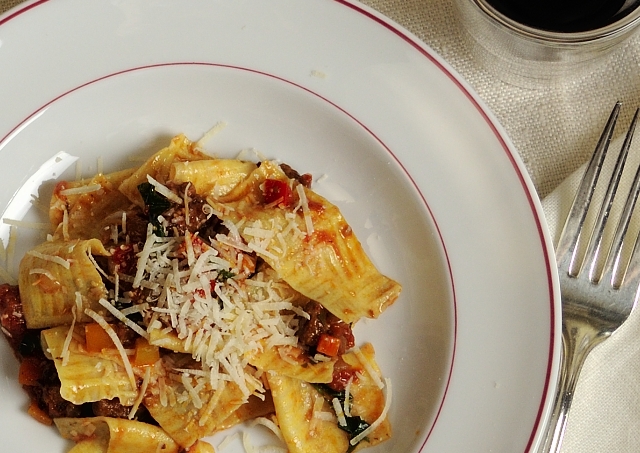
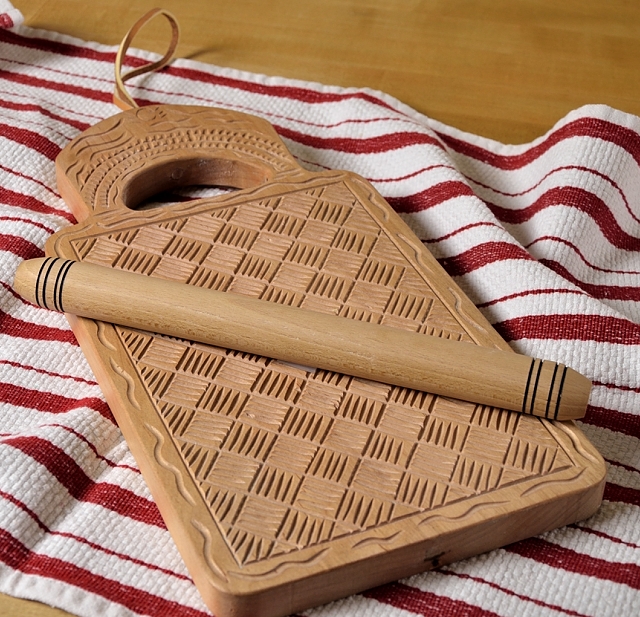

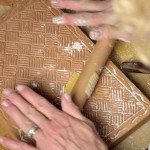

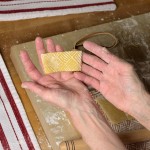
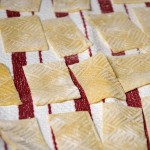
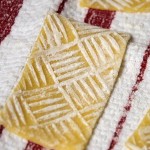
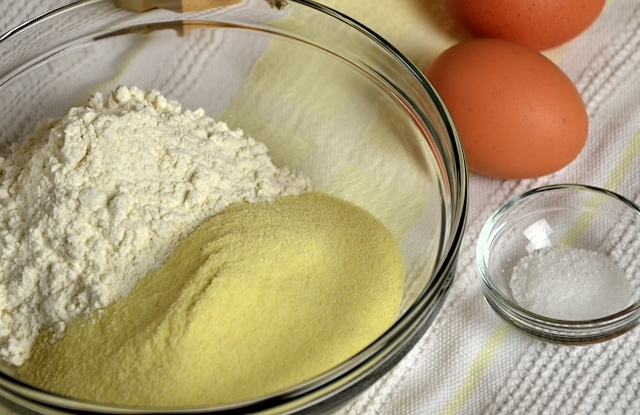

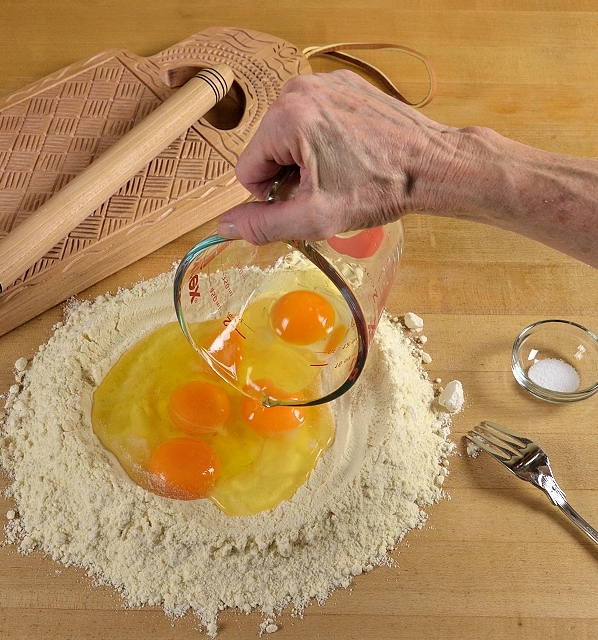
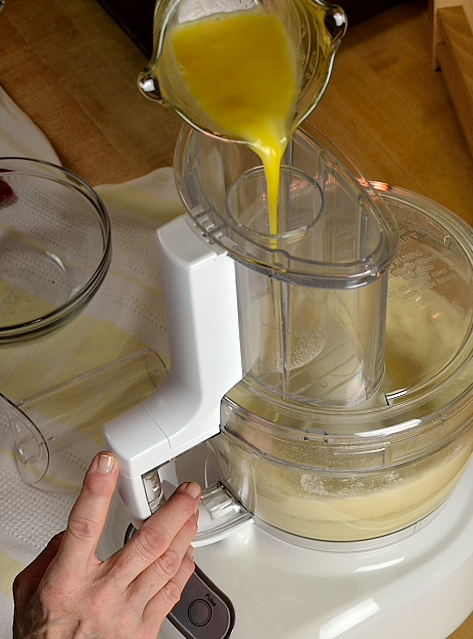
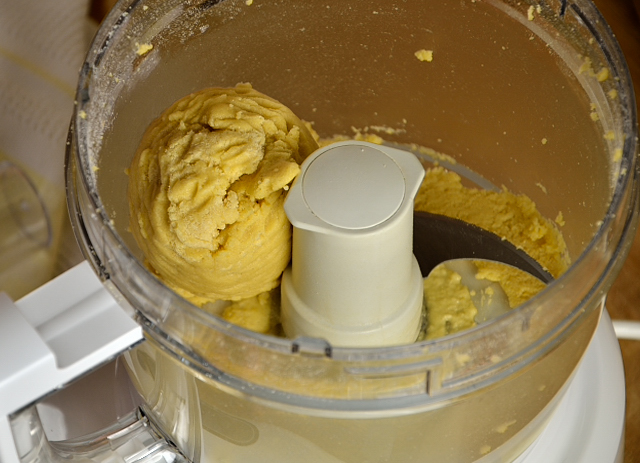

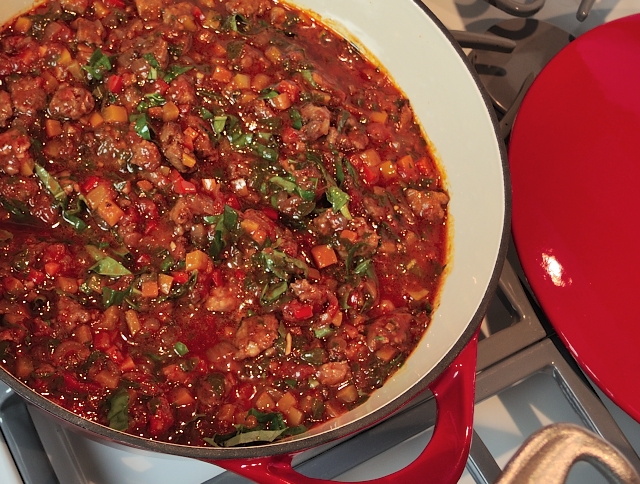


Saturday, August 24th 2013 at 4:53 pm |
Un capolavoro, amica mia. Davvero bellissima questa pasta che sa di tradizione e calore! Complimenti, quello strumento mi mette tanta tenerezza! Ricorda i tempi dei nonni.Bacione!
Saturday, August 24th 2013 at 5:06 pm |
Ciao Ely,
Grazie. I tempi dei nonni – fantastico. Questa pasta e buonissima, davvero. Mio marito ed io abbiamo fatto una scorpacciata! Spero che tu provarla. Un abbraccio a te!
Saturday, August 24th 2013 at 9:05 pm |
What a fancy beautiful pasta board!! Ain\’t homemade pasta is the BEST! The sausage ragu…o…my..I think I am in the comfort food heaven!
Saturday, August 24th 2013 at 9:17 pm |
BenvenutaAngie!
I just love this cavarola board. The past is beautiful, and really simple to make. I’m glad you like this one – it’s soul satisfying food, for certain. Have a wonderful weekend!
Sunday, August 25th 2013 at 6:56 am |
Fabulous post Adri. My favorite combination: sausage and peppers. I have made pasta with the combined flours but never in the shape you demonstrate here. I will definitely make this authentic recipe. Thanks for sharing.
Jovina
Sunday, August 25th 2013 at 7:25 am |
Ciao Jovina!
Thanks. I hope you try this. It is so pretty, and always a conversation starter!
Sunday, August 25th 2013 at 7:41 am |
I will definitely make this and I looked at Terry’s website to check out the boards.
Sunday, August 25th 2013 at 7:44 am |
Hi Jovina,
Terry produces some wonderful things, and he has a strong commitment to keeping the old ways alive.
Sunday, August 25th 2013 at 7:37 am |
Lovely pasta dish Adri!
Sunday, August 25th 2013 at 7:44 am |
Ciao Deborah,
I’m glad this caught your eye. It is so beautiful, and always gets raves!
Sunday, August 25th 2013 at 7:46 am |
Adri my first choice has always been a meat sauce for pasta and this one sounds like a knock out
Sunday, August 25th 2013 at 7:49 am |
Hi Anthony,
Funny, but I thought of you when I made this. I seem to remember that you told me your Mom used to make Sausage and Peppers for supper when you were growing up. Am I remembering correctly?
Sunday, August 25th 2013 at 10:23 am |
What a beautiful pasta board! Just when I think I don’t need anything more for my kitchen here you are tempting me 🙂 I love flat pastas and will be putting one of these boards on my wish list. The sausage ragu sounds delicious!
Sunday, August 25th 2013 at 10:26 am |
Hi Susan,
This one is one of my favorites. Later this week I’ll be featuring yet another flat pasta. I’ll let you know when the article is up. Have a wonderful Sunday.
Sunday, August 25th 2013 at 10:30 am |
I love when you do your posts with cool –historic–instruments for making pasta. Your Maccheroni alla Chitarra was one of my favorites, and now this is another. That Cavarola board is neat and the pasta looks so pretty. Thank you for revealing this culinary equipment secret!
Sunday, August 25th 2013 at 10:36 am |
Ciao Trisha,
I do love these old methods. I find myself increasingly drawn to the history of Italian cuisine, all the way back to the Empire and up through today. I am ever more curious about changes and trends in farming and agricultural practices and in today’s efforts to revive the old ways. Maybe I should have been a food anthropologist!
Sunday, August 25th 2013 at 1:25 pm |
Absolutely beautiful photos and spot on directions (as usual)! What time is dinner?
Sunday, August 25th 2013 at 4:03 pm |
Ciao Laney,
Thanks for the kind words. I enjoy these old pasta shapes, the ones we do not see too often. The first time I wrote about stracnar was several years ago, and I am very pleased to see that others are writing about it now as well. It is good to know that the old ways are undergoing a real revival.
Sunday, August 25th 2013 at 3:15 pm |
What an interesting post! I have never made pasta at home I’m embarrassed to say and I am really tempted by this recipe. I’m going to Chicago next week to visit my daughter and we love shopping in the great Italian delis there. Maybe I will be lucky and find something similar to your cavarola board. I would be tempted to buy it. That sauce looks delicious.
Sunday, August 25th 2013 at 4:08 pm |
Hi Cathy,
Trust me. You can make pasta at home. No hassle. And the great thing about it is that if your dough is not right – too sticky or too dry, or just downright unmanageable for what ever reason, you can discard it and begin again without breaking the bank. I know that Terry Mirri of Artisanal Pasta Tools sells the boards online, but perhaps you will get lucky in the Italian market. I hope so. This pasta is wonderful, and I can only imagine the gorgeous plate you would put together with it.
Monday, August 26th 2013 at 7:55 am |
Even if you never made pasta with it, that board is beautiful enough to hang on the wall as art. But what pasta you did make – simply gorgeous. And that ragù, oh wow, it looks so intensely flavorful.
Monday, August 26th 2013 at 9:06 am |
Ciao Linda,
I so enjoy making this pasta. It’s beautiful, and I love the sense of tradition that surrounds it. Bart gobbled this sauce – it’s hearty food, davvero!
Monday, August 26th 2013 at 8:46 am |
Hi Adri! Thank you so much for stopping by my blog. It is so nice meeting you and being introduced to your blog. This is a beautiful post. I love the embossed pasta. I have made my own pasta before but I need quite a bit more practice to be truly satisfied with the results. I will be trying your sausage ragu as soon as I get a change.
Monday, August 26th 2013 at 9:08 am |
Benvenuta KAren,
And thank you for stopping by. I am glad this one caught your eye. It is indeed unique, and it is my pleasure to introduce it to you. Alla prossima!
Monday, August 26th 2013 at 4:08 pm |
Oh heavens, this looks like the most perfect meal ever. I already have tonight’s dinner planned (steak, corn, mac + cheese + veggies) but now I’m craving pasta with meat sauce instead. NOM!
Monday, August 26th 2013 at 4:18 pm |
Ciao Amy,
I’m glad you like this. Just think, when your daughter is a bit older you two can make pasta together. I want to see those photographs!
Monday, August 26th 2013 at 5:12 pm |
Adri, did you know that before I plunged myself into the world of pasta to write the pasta book, I always thought my pasta recipe was “wrong” because it included semolina. Here in the US, we’re given the impression that the “correct” way to make pasta is with ‘OO’ flour and eggs, when in fact there are countless ways to make it, aren’t there. My mom always added a little semolina to her pasta dough, and that’s what I do for my all-purpose pasta. I bought one of these beautiful cavarola boards last year after seeing your previous post about it. I have yet to break it out and use it, can you believe it. Must do it soon! Thanks for the reminder of the beauty and versatility of pasta.
Monday, August 26th 2013 at 7:01 pm |
Ciao Domenica,
I absolutely believe what you are saying about semolina. I had a similar experience, and for quite some time I was really confused. Do you suppose that at least part of our ’00’ flour insecurity was due to the initial prevalence of northern Italian cooking in that big Italian food revolution of the eighties? Risotto reigned supreme. Northern Italian was the true alta cucina. We, with our maccheroni alla chitarra, and my friends with their orecchiette and mignuicchie definitely were not. I wonder??
There was right, wrong, and then the real bugaboo “authentic.” There must be as many ways to make pasta as there are cooks. Earlier this month I was talking to a friend about pici. I had only seen it made with “00” flour when inside of a week I saw two recipes, one by a well known blogger and one in La Cucina Italiana, both of which called for semolina. My friend suggested that both recipe writers had perhaps been influenced by restaurant chefs who add semolina to yield a dough that can hold up for delayed service and also stand up to hearty sauces. Nancy Harmon Jenkins, in her book “Flavors of Puglia” wrote that the region’s traditional dough is made of semolina and water, but many housewives add an egg to make the dough easier to work with. So there is yet another wrinkle. Talk about a complex topic!
On the subject of your all-purpose pasta, that dough is a dream to work with. It is surprising that the addition of just a small amount of semolina can make such a difference.
Last, about your cavarola board – TAKE IT OUT OF THE CUPBOARD AND MAKE SOMETHING! How long am I supposed to wait? I hope to see something on your site very soon. It will doubtless be, dare I say it, glorious. Thanks for visiting.
Saturday, August 31st 2013 at 11:56 am |
OK ~ I am taking the cavarola board out this weekend to make pasta for guests who are coming on Wednesday. I’m going to make your stracnar. Thanks for the inspiration, cara.
Oh ~ I almost forgot. Do you think it would be possible to roll out sheets of dough on the board (cut to fit) and then cut them further into little rectangles? Maybe I’ll play around and see what happens…
Saturday, August 31st 2013 at 2:09 pm |
Ciao Domenica,
This is great news. And yes, you can imprint an entire sheet at once and then cut it. That is how Terry Mirri makes his. I have found though, that I just get a bit better, deeper imprinting when I do it one rectangle at a time. I can’t wait to hear how it goes. Have fun, amica.
Tuesday, August 27th 2013 at 5:13 am |
I love that board you use for the pasta! So intricate. This looks delicious
Tuesday, August 27th 2013 at 7:07 am |
Hi Jess,
Welcome! I am glad you like this. It’s a traditional one – part of the old ways of making pasta.
Tuesday, August 27th 2013 at 5:45 am |
A fantastic step by step recipe, Adri. You’ve outdone yourself!
And that board is a thing of beauty. I may have to get it, along with the other delights on Artisanal Pasta Tools.
Tuesday, August 27th 2013 at 7:10 am |
Hi Frank,
Thank you! I hope you do purchase some of Terry’s tools. You would love them. They are works of art themselves, their beauty enhanced by their functionality. I just love the idea that so many of us are involved in keeping the old ways alive.
Tuesday, August 27th 2013 at 6:21 pm |
Such a great post. I’ve never seen this type of pasta before. I’d love to sit down to a plate of this.
Tuesday, August 27th 2013 at 7:16 pm |
Welcome Barbara,
Thank you. I am so pleased to be able top introduce this pasta to you. I hope you have an opportunity to try it. Thank you for visiting.
Tuesday, August 27th 2013 at 7:23 pm |
Ciao Adri! Thank you for stopping by our site and its wonderful to meet you as well. What a fabulous recipe for sausage and pepper ragu! This one brings back sweet memories. I also love how you show the steps for making homemade pasta with the board, even though we don’t have one. Our family is from Naples, amd our mom always made her pastas with semolina in the mix too. Oh how we miss those days when we use to have our family gatherings in the kitchen! Love your blog and recipes. We will be regular readers too!
Tuesday, August 27th 2013 at 10:35 pm |
Ciao!
I am so pleased that you are visiting, and I am delighted to hear that you enjoyed this post. OK – now I can add your family to the “pro-semolina” side. Earlier today I received a comment from another reader whose family alos put semolina in the mix for their pasta. I look forward to many visits between our sites. Alla prossima!
Wednesday, August 28th 2013 at 5:56 am |
I spent several weeks in Calabria in the fall and longed to travel to Puglia and the other coast. This pasta is fascinating. I definitely need to visist the region.
Wednesday, August 28th 2013 at 11:40 am |
Welcome!
Thank you for stopping by! This is but one of the many wonderful foods Puglia has to offer. From olive oil to wheat, and all points in between, you will find Nature’s bounty in abundance. Next trip – Puglia!
Wednesday, August 28th 2013 at 6:47 pm |
Food processor method for me, please. 😉 Although one of these days I really need to master making pasta by hand. I’ve done it, but I’m slow and clumsy. Anyway, such a lovely dish! Loads of flavor. This looks terrific – thanks.
Wednesday, August 28th 2013 at 9:55 pm |
Benvenuto John,
The processor method works beautifully, and it is fast. I say if you use it and it works well for you, then stick with it. Don’t mess with success! I’m glad you liked this dish, and thanks so much for visiting!
Wednesday, August 28th 2013 at 7:52 pm |
I would adore having one of those boards to make pasta with, how artistic and pleasing to plate and then, best of all, dig into. I love both recipes and will look back here once our weather cools a bit, which it has just begun to do!
Wednesday, August 28th 2013 at 10:00 pm |
Benvenuta Barbara,
Thanks for stopping by! This shape is fun to make and truly unique, and the cavarola board is exceptional. I hope you treat yourself to a board. It would be in your family for generations.
Thursday, August 29th 2013 at 10:23 am |
Hi Adri, I love everything about this post—the pasta, the ragu, the Board, the stories behind them.
I can see that a cavarola will be going on to my wish list. Cheers!
Thursday, August 29th 2013 at 12:14 pm |
Hi Nancy,
I am glad you like this. I enjoy these old ways of making pasta, and it is my pleasure to share. Have a wonderful weekend!
Thursday, August 29th 2013 at 11:56 am |
I’m sure those ridges just catch all the sauce so perfectly. GREG
Thursday, August 29th 2013 at 12:16 pm |
Ciao Greg,
Exactly! The old ways are sometimes the best.
Saturday, August 31st 2013 at 4:49 pm |
Adri, Between jet lag recovery and plunging into tomato sauce-making, I missed this beautiful post. I love the marriage of the Italian-American S&P classic with this old-world pasta tool. As you know, I’m also a huge fan of Terry Mirri’s artisanal pasta tools and the cavarola board is my favorite. I haven’t played with mine in quite a while – just as soon as my kids are back to school, I need to dust mine off and get to work. A presto, Michelle
Saturday, August 31st 2013 at 5:05 pm |
Hi Michelle,
Thanks – this is such tasty food, a satisfying kind of meal. I’m glad you like it. Get that cavarola board out! So many of us own them now, we need to form a club!
Sunday, September 1st 2013 at 8:55 pm |
The stracnar pasta you made on the cavarola board look so beautiful and your ragu looks so tempting, Adri! Pasta made this way is a work of art!
Sunday, September 1st 2013 at 9:08 pm |
Thanks, Pat,
This one is an “old ways” pasta. I love to do it, and it is quite the conversation starter, as you can imagine.
Sunday, September 8th 2013 at 8:01 am |
Wow! This pasta sounds fabulous. That board is so cool!
LL
Sunday, September 8th 2013 at 8:55 am |
Ciao!
It’s lovely, and made even more so by the hundreds of years of tradition behind it. Thanks for stopping by and for your comment.
Saturday, October 19th 2013 at 4:31 am |
Stunning work Adri! It’s 7:30 in the morning here, and I could eat this for breakfast, easily. We get into some serious arguments in this house about what pasta to have with what sauce, and if I had your beautiful wooden board I would trump them all! This truly is a lovely dish, both visually and full of flavor 🙂
Saturday, October 19th 2013 at 9:06 am |
Thanks, Emilie!
I love hand made pasta, and this is one you do not see terribly often. I also use the board to make ravioli, and it is really lovely – completely non-traditional, but lovely just the same.